Insights from 30 Years of Land Use/Land Cover Transitions in Jakarta, Indonesia, via Intensity Analysis
Abstract
:1. Introduction
2. Materials and Methods
2.1. Study Area
2.2. Data Collection and Processing
2.3. Land Use Classification
2.4. LULC Identification
2.5. Intensity Analysis and Transition Pattern
2.6. Identification of Driving Forces
3. Research Results
3.1. LULC Classification and Accuracy
3.2. Interval Change
3.3. LULC Transition Pattern
3.4. LULC Driving Forces
4. Discussion
4.1. Transition of LULC Changes
4.2. Driving Forces of LULC
4.3. Limitations of the Study and Future Insights
5. Conclusions
Supplementary Materials
Author Contributions
Funding
Data Availability Statement
Acknowledgments
Conflicts of Interest
References
- Aldwaik, S.Z.; Pontius, R.G., Jr. Intensity analysis to unify measurements of size and stationarity of land changes by interval, category, and transition. Landsc. Urban.Plan. 2012, 106, 103–114. [Google Scholar] [CrossRef]
- Turner, B.L., II; Meyer, W.B. Changes in land use and land cover: A global perspective. In Global Land-Use and Land-Cover Change: An Overview; Turner, B.L., Meyer, W.B., Eds.; Cambridge University Press: Cambridge, UK, 1994; pp. 3–12. [Google Scholar]
- Devkota, P.; Dhakal, S.; Shrestha, S.; Shrestha, U.B. Land use land cover changes in the major cities of Nepal from 1990 to 2020. Environmental and Sustainability Indicators. Environ. Sustain. Indic. 2023, 17, 100227. [Google Scholar]
- Sun, L.; Chen, J.; Li, Q.; Huang, D. Dramatic uneven urbanization of large cities throughout the world in recent decades. Nat. Commun. 2020, 11, 5366. [Google Scholar] [CrossRef] [PubMed]
- Clerici, N.; Cote-Navarro, F.; Escobedo, F.J.; Rubiano, K.; Villegas, J.C. Spatio-temporal and cumulative effects of land use-land cover and climate change on two ecosystem services in the Colombian Andes. Sci. Total Environ. 2019, 685, 1181–1192. [Google Scholar] [CrossRef] [PubMed]
- Dupras, J.; Marull, J.; Parcerisas, L.; Coll, F.; Gonzalez, A.; Girard, M.; Tello, E. The impacts of urban sprawl on ecological connectivity in the Montreal Metropolitan Region. Environ. Sci. Policy 2016, 58, 61–73. [Google Scholar] [CrossRef]
- Zhang, Y.; Liu, Y.; Zhang, Y.; Liu, Y.; Zhang, G.; Chen, Y. On the spatial relationship between ecosystem services and urbanization: A case study in Wuhan, China. Sci. Total Environ. 2018, 637–638, 780–790. [Google Scholar] [CrossRef] [PubMed]
- Macleod, R.D.; Congalton, R.G. A quantitative comparison of change—Detection algorithms for monitoring eelgrass from remotely sensed data. Photogramm. Eng. Remote Sens. 1998, 64, 207–216. [Google Scholar]
- Nagendra, H.; Munroe, D.K.; Southworth, J. From pattern to process: Land—Scape fragmentation and the analysis of land use/land cover change. Agric. Ecosyst. Environ. Plan. 2004, 101, 111–115. [Google Scholar] [CrossRef]
- Pontius, R.G., Jr.; Shusas, E.; McEachern, M. Detecting important categorical land changes while accounting for persistence. Agric. Ecosyst. Environ. 2004, 101, 251–268. [Google Scholar] [CrossRef]
- Serneels, S.; Lambin, E.F. Proximate causes of land-use change in Narok District, Kenya: A spatial statistical model. Agric. Ecosyst. Environ. 2001, 85, 65–81. [Google Scholar] [CrossRef]
- Shoyama, K.; Braimoh, A.K. Analyzing about sixty years of land-cover change and associated landscape fragmentation in Shiretoko Peninsula, Northern Japan. Landsc. Urban Plan. 2011, 101, 22–29. [Google Scholar] [CrossRef]
- Xu, Q.; Dong, Y.-X.; Yang, R. Influence of land urbanization on carbon sequestration of urban vegetation: A temporal cooperativity analysis in Guangzhou as an example. Sci. Total Environ. 2018, 635, 26–34. [Google Scholar] [CrossRef] [PubMed]
- Ye, Y.; Bryan, B.A.; Zhang, J.; Connor, J.D.; Chen, L.; Qin, Z.; He, M. Changes in land-use and ecosystem services in the Guangzhou-Foshan Metropolitan Area, China from 1990 to 2010: Implications for sustainability under rapid urbanization. Ecol. Indic. 2018, 93, 930–941. [Google Scholar] [CrossRef]
- Kontgis, C.; Schneider, A.; Fox, J.; Saksena, S.; Spencer, J.H.; Castrence, M. Monitoring peri-urbanization in the greater Ho Chi Minh City metropolitan area. Appl. Geogr. 2014, 53, 377–388. [Google Scholar] [CrossRef]
- Xu, G.; Jiao, L.; Liu, J.; Shi, Z.; Zeng, C.; Liu, Y. Understanding urban expansion combining macro patterns and micro dynamics in three Southeast Asian megacities. Sci. Total Environ. 2019, 660, 375–383. [Google Scholar] [CrossRef] [PubMed]
- Huang, S.; Tang, L.; Hupy, J.P.; Wang, Y.; Shao, G. A commentary review on the use of normalized difference vegetation index (NDVI) in the era of popular remote sensing. J. For. Res. 2021, 32, 2719. [Google Scholar] [CrossRef]
- Lambin, E.F.; Geist, H.J.; Lepers, E. Dynamics of land-use and land-cover change in tropical regions. Annu. Rev. Environ. Resour. 2003, 28, 205–241. [Google Scholar] [CrossRef]
- Liping, C.; Yujun, S.; Saeed, S. Monitoring and predicting land use and land cover changes using remote sensing and GIS techniques—A case study of a hilly area, Jiangle, China. PLoS ONE 2018, 13, e0200493. [Google Scholar] [CrossRef]
- Niya, A.K.; Huang, J.; Karimi, H.; Keshtkar, H.; Naimi, B. Use of Intensity Analysis to Characterize Land Use/Cover Change in the Biggest Island of Persian Gulf, Qeshm Island, Iran. Sustainability 2019, 11, 4396. [Google Scholar] [CrossRef]
- Mwangi, H.M.; Lariu, P.; Julich, S.; Patil, S.D.; McDonald, M.A.; Feger, K.-H. Characterizing the Intensity and Dynamics of Land-Use Change in the Mara River Basin, East Africa. Forests 2018, 9, 8. [Google Scholar] [CrossRef]
- Quan, B.; Ren, H.; Pontius, R.G., Jr.; Liu, P. Quantifying spatiotemporal patterns concerning land change in Changsha, China. Landsc. Ecol. Eng. 2018, 14, 257–267. [Google Scholar] [CrossRef]
- Huang, J.; Pontius, R.G., Jr.; Li, Q.; Zhang, Y. Use of intensity analysis to link patterns with processes of land change from 1986 to 2007 in a coastal watershed of southeast China. Appl. Geogr. 2012, 34, 371–384. [Google Scholar] [CrossRef]
- Dembélé, F.; Guuroh, R.T.; Ansah, P.B.; Asare, D.-C.B.M.; Da, S.S.; Aryee, J.N.; Adu-Bredu, S. Land use land cover change and intensity analysis of land transformation in and around a moist semi-deciduous forest in Ghana. Trees For. People 2024, 15, 100507. [Google Scholar] [CrossRef]
- Adjei, V.; Antwi, M. Land use change detection using the intensity analysis at the Bosomtwe District, Ashanti Region, Ghana. Smart Agric. Technol. 2023, 5, 100290. [Google Scholar] [CrossRef]
- Deguenon, S.D.D.M.; Baguere, O.F.; Teka, O.; Aheto, D.W.; Sinsin, B. Using of intensity analysis approach in Benin coastal zone (West Africa) to assess land use/land cover change for further decision making. Heliyon 2022, 8, e12384. [Google Scholar] [CrossRef] [PubMed]
- Huang, B.; Huang, J.; Pontius, R.G., Jr.; Tu, Z. Comparison of Intensity Analysis and the land-use dynamicdegrees to measure land changes outside versus inside the coastal zone of Longhai, China. Ecol. Indic. 2018, 89, 336–347. [Google Scholar] [CrossRef]
- Wang, J.; Zhou, W.; Pickett, S.T.; Yu, W.; Li, W. A multiscale analysis of urbanization effects on ecosystem services supply in an urban megaregion. Sci. Total Environ. 2019, 662, 824–833. [Google Scholar] [CrossRef] [PubMed]
- Zhang, P.; Yang, D.; Qin, M.; Jing, W. Spatial heterogeneity analysis and driving forces exploring of built-up land development intensity in Chinese prefecture-level cities and implications for future Urban Land intensive use. Land Use Policy 2020, 99, 104958. [Google Scholar] [CrossRef]
- Azhdari, A.; Sasani, M.A.; Soltani, A. Exploring the relationship between spatial driving forces of urban expansion and socioeconomic segregation: The case of Shiraz. Habitat. Int. 2018, 81, 33–34. [Google Scholar] [CrossRef]
- Su, S.; Ma, X.; Xiao, R. Agricultural landscape pattern changes in response to urbanization at ecoregional scale. Ecol. Indic. 2014, 40, 10–18. [Google Scholar] [CrossRef]
- Remondi, F.; Burlando, P.; Vollmer, D. Exploring the hydrological impact of increasing urbanisation on a tropical river catchment of the metropolitan Jakarta, Indonesia. Sustain. Cities Soc. 2016, 20, 210–221. [Google Scholar] [CrossRef]
- Poerbandono, J.M.; Ward, P. Assessment of the effects of climate and land cover changes on river discharge and sediment yield, and an adaptive spatial planning in the Jakarta region. Nat. Hazards 2014, 73, 507–530. [Google Scholar] [CrossRef]
- Ward, P.; Pauw, W.; Van Buuren, M.; Marfai, M. Governance of flood risk management in a time of climate change: The cases of Jakarta and Rotterdam. Environ. Politics 2013, 22, 518–536. [Google Scholar] [CrossRef]
- Central Statistical Agency of Jakarta (BPS Jakarta 2023). 2023. Available online: https://jakarta.bps.go.id/publication/2023/02/28/fd35fcb5d10a1e03f0d71348/provinsi-dki-jakarta-dalam-angka-2023.html (accessed on 24 February 2024).
- Varga, O.G.; Pontius, R.G., Jr.; Singh, S.K.; Szabó, S. Intensity Analysis and the Figure of Merit’s components for assessment of a Cellular Automata—Markov simulation model. Ecol. Indic. 2019, 101, 933–942. [Google Scholar] [CrossRef]
- Xie, Z.; Pontius, R.G., Jr.; Huang, J.; Nitivattananon, V. Enhanced Intensity Analysis to Quantify Categorical Change and to Identify Suspicious Land Transitions: A Case Study of Nanchang, China. Remote Sens. 2020, 12, 3323. [Google Scholar] [CrossRef]
- Waleed, M.; Sajjad, M. On the emergence of geospatial cloud-based platforms for disaster risk management: A global scientometric review of google earth engine applications. Int. J. Disaster Risk Reduct. 2023, 97, 104056. [Google Scholar] [CrossRef]
- Zaki, A.; Buchori, I.; Pangi, P.; Sejati, A.W.; Liu, Y. Google Earth Engine for improved spatial planning in agricultural and forested lands: A method for projecting future ecological quality. Remote Sens. Appl. Soc. Environ. 2023, 32, 101078. [Google Scholar] [CrossRef]
- Aji, M.A.P.; Kamal, M.; Farda, N.M. Mangrove species mapping through phenological analysis using random forest algorithm on Google Earth Engine. Remote Sens. Appl. Soc. Environ. 2023, 30, 100978. [Google Scholar] [CrossRef]
- Pratama, M.R.; Riana, D. Land Cover Classification Using Google Earth Engine with Supervised Classification Method in Penajam Paser Utara Area. J. Jupit. 2022, 1, 637–650. [Google Scholar]
- Abdu, H.A. Classification accuracy and trend assessments of land cover- land use changes from principal components of land satellite images. Int. J. Remote Sens. 2019, 40, 1275–1300. [Google Scholar] [CrossRef]
- Chuai, X.; Huang, X.; Wu, C.; Li, J.; Lu, Q.; Qi, X.; Zhang, M.; Zuo, T.; Lu, J. Land Use and Ecosystems Services Value Changes and Ecological Land Management in Coastal Jiangsu, China. Habitat. Int. 2016, 57, 164–174. [Google Scholar] [CrossRef]
- Gashaw, T.; Tulu, T.; Argaw, M.; Worqlul, A.W.; Tolessa, T.; Kindu, M. Estimating the impacts of land use/land cover changes on Ecosystem Service Values: The case of the Andassa watershed in the Upper Blue Nile basin of Ethiopia. Ecosyst. Serv. 2018, 31 Pt A, 219–228. [Google Scholar] [CrossRef]
- Li, R.-Q.; Dong, M.; Cui, J.-Y.; Zhang, L.-L.; Cui, Q.-G.; He, W.-M. Quantification of the Impact of Land-Use Changes on Ecosystem Services: A Case Study in Pingbian County, China. Env. Monit. Assess. 2007, 128, 503–510. [Google Scholar] [CrossRef] [PubMed]
- Mamat, A.; Halik, Ü.; Rouzi, A. Variations of Ecosystem Service Value in Response to Land-Use Change in the Kashgar Region, Northwest China. Sustainability 2018, 10, 200. [Google Scholar] [CrossRef]
- Temesgen, H.; Wei, W.; Legesse, A.; Yirsaw, E.; Bekele, B. Landscape based upstream-downstream prevalence of land use/cover change drivers in southeastern rift escarpment of Ethiopia. Environ. Monit. Assess. 2018, 190, 166. [Google Scholar] [CrossRef] [PubMed]
- Tolessa, T.; Senbeta, F.; Kidane, M. The impact of land use/land cover change on ecosystem services in the central highlands of Ethiopia. Ecosyst. Serv. 2017, 23, 47–54. [Google Scholar] [CrossRef]
- Tømmervik, H.; Høgda, K.A.; Solheim, I. Monitoring vegetation changes in Pasvik (Norway) and Pechenga in Kola Peninsula (Russia) using multitemporal Landsat MSS/TM data. Remote Sens. Environ. 2003, 85, 370–388. [Google Scholar] [CrossRef]
- Aldwaik, S.Z.; Pontius, R.G., Jr. Map errors that could account for deviations from a uniform intensity of land change. Int. J. Geogr. Inf. Sci. 2013, 27, 1717–1739. [Google Scholar] [CrossRef]
- Enaruvbe, G.O.; Pontius, R.G., Jr. Influence of classification errors on Intensity Analysis of land changes in southern Nigeria. Int. J. Remote Sens. 2015, 36, 244–261. [Google Scholar] [CrossRef]
- Liu, Y.; Yang, M.; Cui, J. Urbanization, economic agglomeration and economic growth. Heliyon 2024, 10, e23772. [Google Scholar] [CrossRef]
- Zhang, X.Q. The trends, promises and challenges of urbanisation in the world. Habitat. Int. 2016, 54, 241–252. [Google Scholar] [CrossRef]
- Li, T.; Wu, X.; He, Y.; Peng, X.; Yang, J.; Ding, R.; He, C. Small samples noise prediction of train electric traction system fan based on a multiple regression-fuzzy neural network. Eng. Appl. Artif. Intell. 2023, 126, 106781. [Google Scholar] [CrossRef]
- Winarso, H.; Firman, T. Residential Land Development in Jabodetabek, Indonesia: Trigeriing Economic Crisis? Habitat Int. 2002, 26, 487–506. [Google Scholar] [CrossRef]
- Central Statistical Agency of Jakarta (BPS Jakarta 2000). 2000. Available online: https://jakarta.bps.go.id/publication/2015/04/10/a7408e7e536279dd08a8dc11/jakarta-dalam-angka-2000.html (accessed on 12 January 2022).
- Central Statistical Agency of Jakarta (BPS Jakarta 1991). 1991. Available online: https://jakarta.bps.go.id/publication/1991/12/02/bf7f8e9d26123fa1bfe2a054/jakarta-dalam-angka-tahun-1991.html (accessed on 12 January 2022).
- Central Statistical Agency of Jakarta (BPS Jakarta 2021). 2021. Available online: https://jakarta.bps.go.id/publication/2021/02/26/bb7fa6dd5e90b534e3fa6984/provinsi-dki-jakarta-dalam-angka-2021.html (accessed on 13 January 2022).
- Kuddus, M.A.; Tynan, E.; McBryde, E. Urbanization: A problem for the rich and the poor? Public Health Rev. 2020, 41, 1. [Google Scholar] [CrossRef] [PubMed]
- Thacker, S.; Adshead, D.; Fay, M.; Hallegatte, S.; Harvey, M.; Meller, H.; O’Regan, N.; Rozenberg, J.; Watkins, G.; Hall, J.W. Infrastructure for sustainable development. Nat. Sustain. 2019, 2, 324–331. [Google Scholar] [CrossRef]
- Rushayati, S.B.; Prasetyo, L.B.; Puspaningsih, N.; Rachmawati, E. Adaptation strategy toward urban heat island at tropical urban area. Procedia Environ. Sci. 2016, 33, 221–229. [Google Scholar] [CrossRef]
- Zain, A.M. Distribution, Structure and Function of Urban Green Space in Southeast Asian Mega-Cities with Special Reference to Jakarta Metropolitan Region (Jabotabek). Ph.D. Thesis, Department of Agricultural and Environmental Biology, Graduate School of Agricultural and Life Sciences, The University of Tokyo, Tokyo, Japan, 2002. [Google Scholar]
- Yang, Y.; Liu, Y.; Xu, D. Use of intensity analysis to measure land use changes from 1932 to 2005 in Zhenlai County, Northeast China. Chin. Geogr. Sci. 2017, 27, 441–455. [Google Scholar] [CrossRef]
- Central Statistical Agency of Jakarta (BPS Jakarta 2011). 2011. Available online: https://jakarta.bps.go.id/publication/2012/01/25/2bc157eb132ba603e8fb36ed/jakarta-dalam-angka-2011.html (accessed on 12 January 2022).
- Central Statistical Agency of Jakarta (BPS Jakarta 2006). 2006. Available online: https://jakarta.bps.go.id/publication/2009/01/01/786d3ba6b8fda9e83af2f4af/jakarta-dalam-angka-2006.html (accessed on 12 January 2022).
- Akber, M.A.; Khan, M.W.R.; Islam, M.A.; Rahman, M.M.; Rahman, M.R. Impact of Land Use Change on Ecosystem Services of Southwest Coastal Bangladesh. J. Land Use Sci. 2018, 13, 238–250. [Google Scholar] [CrossRef]
- Dong, Y.; Yuan, J.; Li, J.; Liu, D.; Qiu, Y.; Zhang, X.; Xiang, J.; Ding, W. Conversion of natural coastal wetlands to mariculture ponds dramatically decreased methane production by reducing substrate availability. Agric. Ecosyst. Environ. 2023, 356, 108646. [Google Scholar] [CrossRef]
- Najah, F.T.; Abdullah, S.F.K.; Abdulkareem, T.A. Urban Land Use Changes: Effect of Green Urban Spaces Transformation on Urban Heat Islands in Baghdad. Alex. Eng. J. 2022, 66, 555–571. [Google Scholar] [CrossRef]
- Namwinbown, T.; Imoro, Z.A.; Weobong, C.A.-A.; Tom-Dery, D.; Baatuuwie, B.N.; Aikins, T.K.; Poreku, G.; Lawer, E.A. Patterns of green space change and fragmentation in a rapidly expanding city of northern Ghana, West Africa. City Environ. Interact. 2024, 21, 100136. [Google Scholar] [CrossRef]
- Rizal, A.; Haykal, F. Land use changes analysis in Jakarta Bay coastal area between 1998, 2008 and 2018. J. Segara 2021, 17, 135–144. [Google Scholar] [CrossRef]
- Munsi, M.; Malaviya, S.; Oinam, G.; Joshi, P.K. A landscape approach for quantifying land-use and land-cover change (1976–2006) in middle Himalaya. Reg. Environ. Chang. 2009, 10, 145–155. [Google Scholar] [CrossRef]
- Patra, S.; Sahoo, S.; Mishra, P.; Mahapatra, S.C. Impacts of urbanization on land use/cover changes and its probable implications on local climate and groundwater level. J. Urban Manag. 2018, 7, 70–84. [Google Scholar] [CrossRef]
- Central Statistical Agency of Jakarta (BPS Jakarta 2014). 2014. Available online: https://jakarta.bps.go.id/publication/2014/10/21/bb081af3fabf3f5432c74056/jakarta-dalam-angka-2014.html (accessed on 14 January 2022).
- Fu, Y.; Zhou, T.; Yao, Y.; Qiu, A.; Wei, F.; Liu, J.; Liu, T. Evaluating efficiency and order of urban land use structure: An empirical study of cities in Jiangsu, China. J. Clean. Prod. 2021, 283, 124638. [Google Scholar] [CrossRef]
- Foley, J.A.; DeFries, R.; Asner, G.P.; Barford, C.; Bonan, G.; Carpenter, S.R.; Chapin, F.S.; Coe, M.T.; Daily, G.C.; Gibbs, H.K.; et al. Global consequences of land use. Science 2005, 309, 570–574. [Google Scholar] [CrossRef]
- Liu, X.P.; Huang, Y.H.; Xu, X.C.; Li, X.C.; Li, X.; Ciasi, P.; Gong, K.; Ziegler, A.D.; Chen, A.P.; Gong, P.; et al. High-spatiotemporal-resolution mapping of global urban change from 1985 to 2015. Nat. Sustain. 2020, 3, 564–570. [Google Scholar] [CrossRef]
- Malek, Ž.; Verburg, P.H. Mapping global patterns of land use decision-making. Glob. Environ. Chang. 2020, 65, 102170. [Google Scholar] [CrossRef]
- Chen, Z.; Zhou, Y.; Haynes, K.E. Change in Land Use Structure in Urban China: Does the Development of High-Speed Rail Make a Difference. Land Use Policy 2020, 111, 104962. [Google Scholar] [CrossRef]
- Chen, Z.; Zhou, Y.; Haynes, K.E. Change in land-use structure due to urbanisation in China. J. Clean. Prod. 2021, 321, 128986. [Google Scholar] [CrossRef]
- Seto, K.C.; Parnell, S.; Elmqvist, T. A global outlook on urbanization. In Urbanization, Biodiversity and Ecosystem Services: Challenges and Opportunities; Springer: Berlin/Heidelberg, Germany, 2013; pp. 1–12. [Google Scholar] [CrossRef]
- Yu, J.; Li, X.; Guan, X.; Shen, H. A remote sensing assessment index for urban ecological livability and its application. Geo-Spat. Inf. Sci. 2024, 27, 289–310. [Google Scholar] [CrossRef]
- Government Regulation Number 23, 1986 (PP 23 1986). Available online: https://peraturan.bpk.go.id/Details/71108/pp-no-23-tahun-1986 (accessed on 14 January 2022).
- Maheng, D.; Pathirana, A.; Zevenbergen, C. A Preliminary Study on the Impact of Landscape Pattern Changes Due to Urbanization: Case Study of Jakarta, Indonesia. Land 2021, 10, 218. [Google Scholar] [CrossRef]
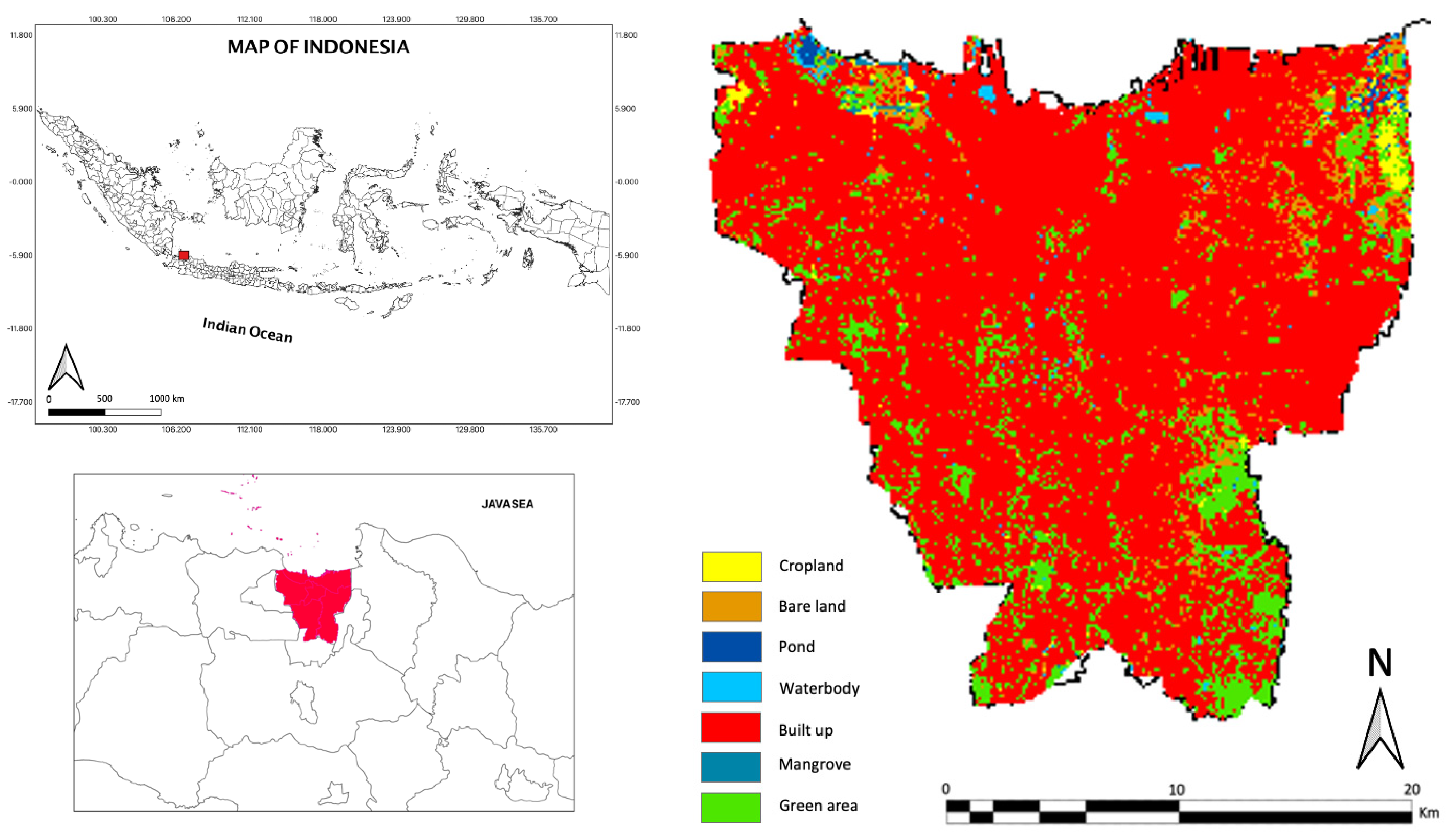
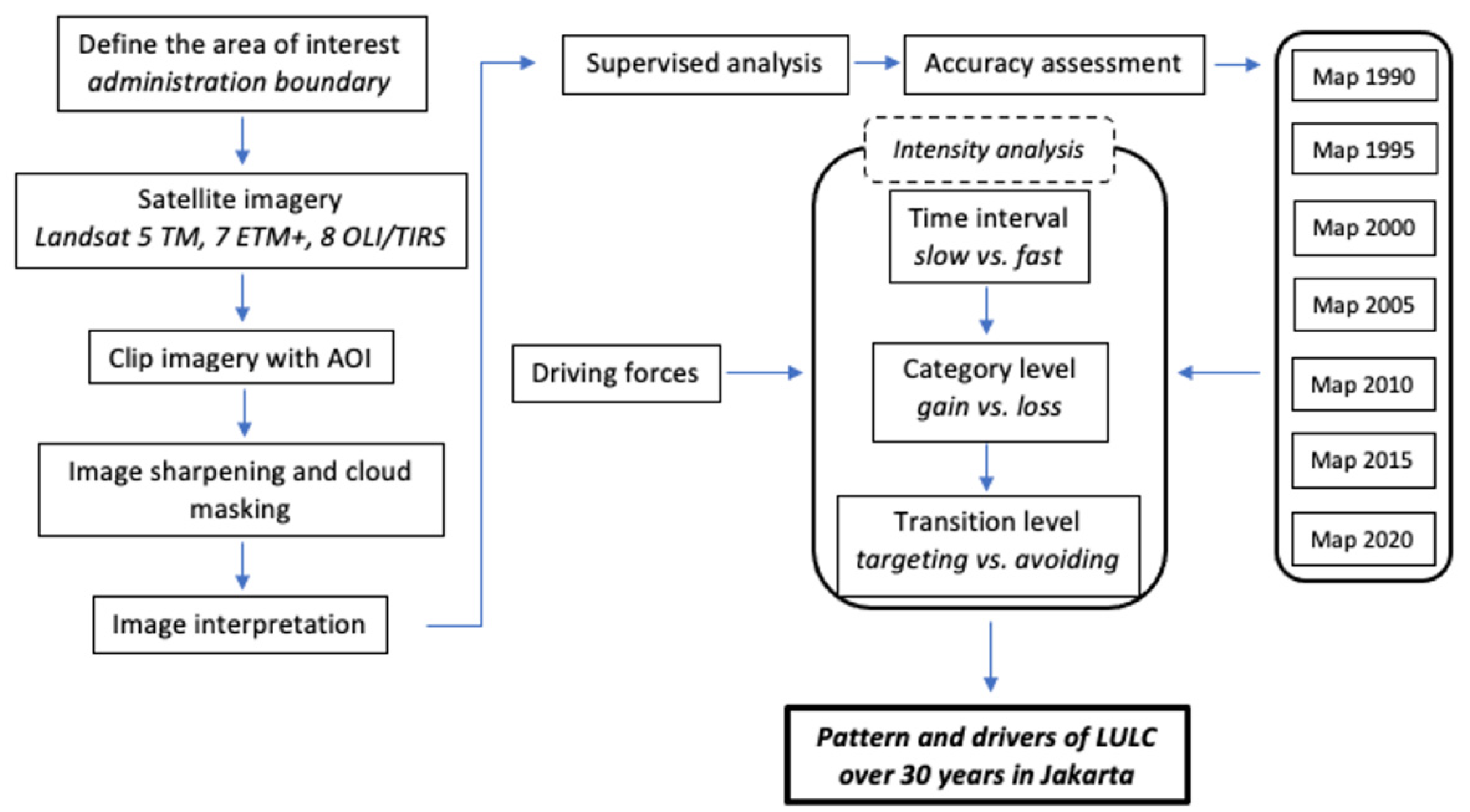

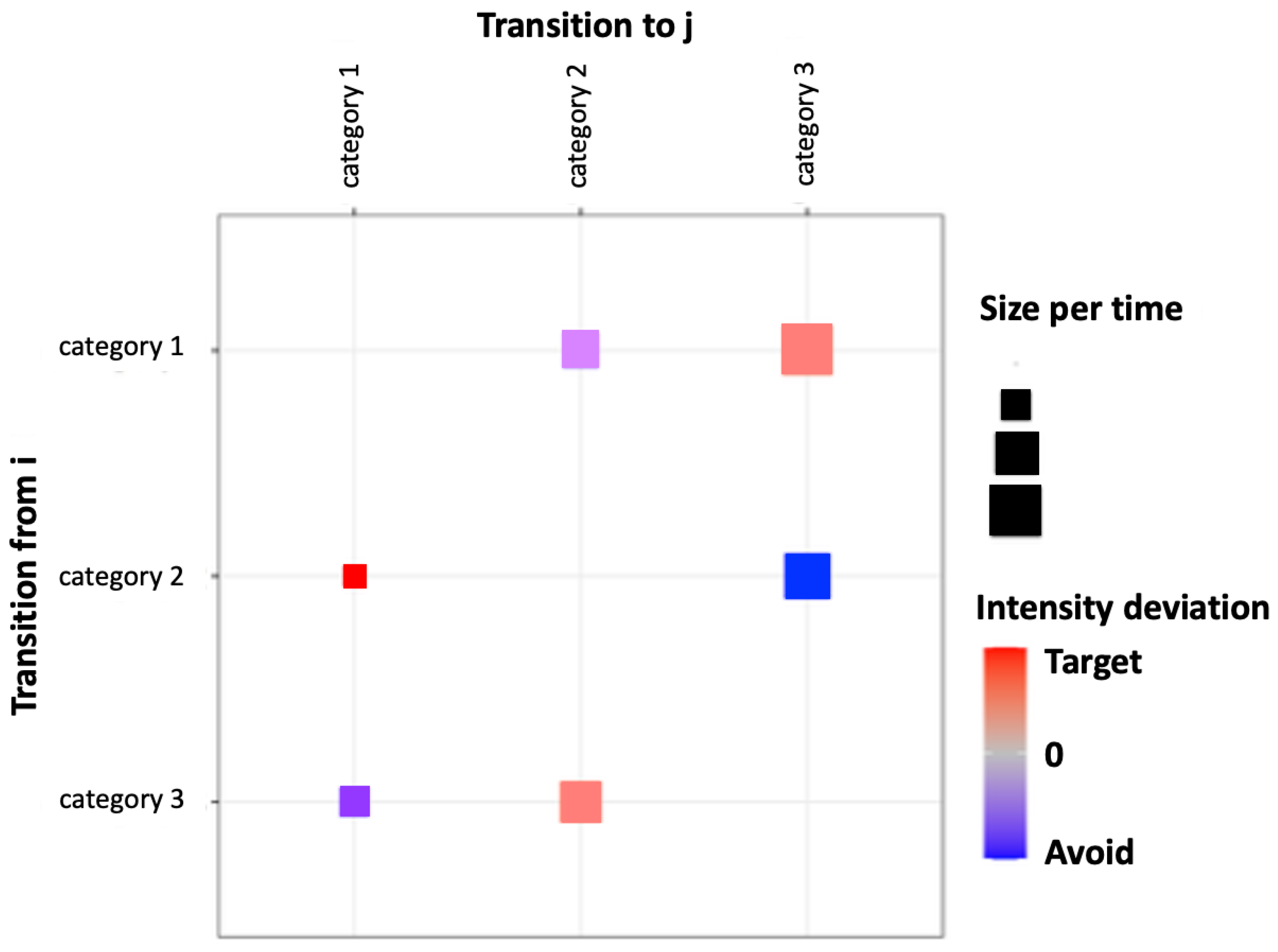

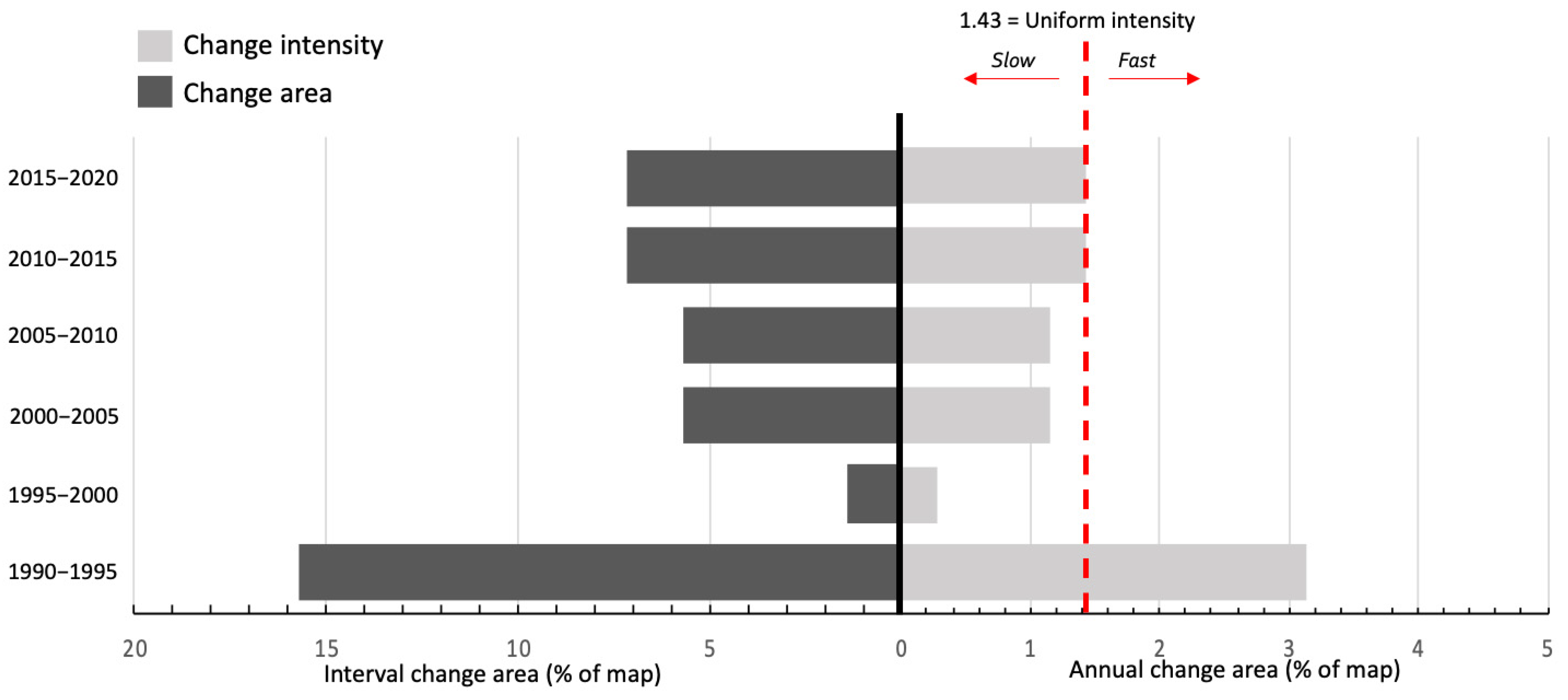
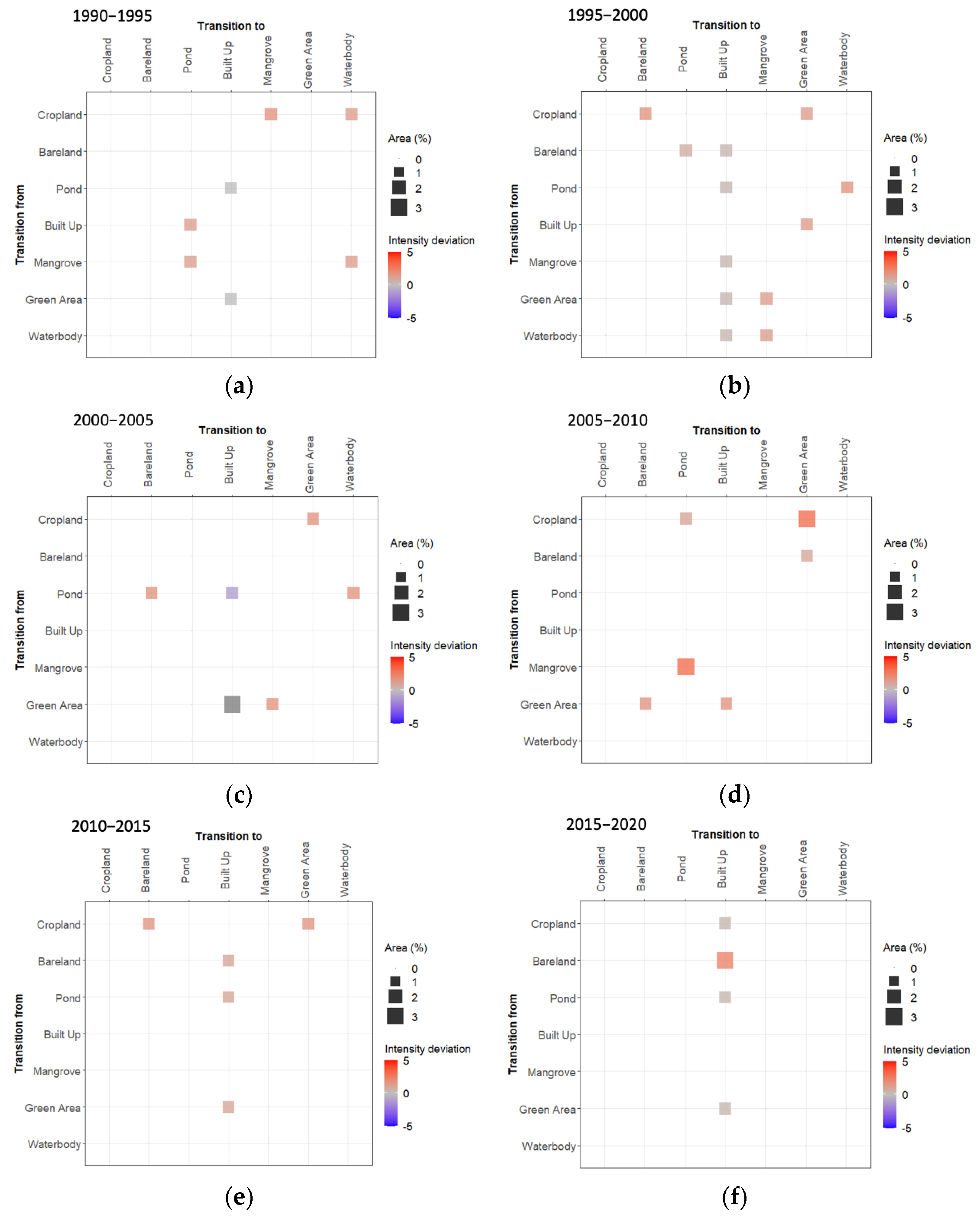

| No | Satellite | Sensors | Path/Row | Date |
|---|---|---|---|---|
| 1 | Landsat 5 | Thematic Mapper (TM) | 122/064 | 11 September 1990 |
| 2 | Landsat 5 | Thematic Mapper (TM) | 122/064 | 24 August 1995 |
| 3 | Landsat 5 | Thematic Mapper (TM) | 122/064 | 8 October 2000 |
| 4 | Landsat 7 | Enhanced Thematic Mapper Plus (ETM+) | 122/064 | 10 July 2005 |
| 5 | Landsat 7 | Enhanced Thematic Mapper Plus (ETM+) | 122/064 | 22 June 2010 |
| 6 | Landsat 8 | Operational Land Imager (OLI) | 122/064 | 31 August 2015 |
| 7 | Landsat 8 | Operational Land Imager (OLI) | 122/064 | 15 October 2020 |
| No | Category | Description |
|---|---|---|
| 1 | Bare land | Unutilized land, such as desolate areas, uncultivated grasslands, marshes, sandy terrain, and unproductive land. |
| 2 | Built-up | Residential area, involving urban and rural areas, industry, all types of roads, airports, surrounding enterprise areas, and typically artificial environments. |
| 3 | Cropland | Land for agriculture gardens and arable land for cultivating various agricultural crops. |
| 4 | Green area | Green spaces or other open spaces on the island not used as agriculture areas. |
| 5 | Mangrove | Mangroves, both natural and artificial. |
| 6 | Waterbody | River, lakes, and inland lakes and rivers. |
| 7 | Pond | Areas for fish/shrimp farming, located in coastal areas. |
| No | Year | Error Count | Sample Count | Overall Accuracy | K-Standard |
|---|---|---|---|---|---|
| 1 | 1990 | 11 | 70 | 84.29 | 81.67 |
| 2 | 1995 | 1 | 70 | 98.57 | 98.33 |
| 3 | 2000 | 3 | 70 | 95.72 | 94.72 |
| 4 | 2005 | 4 | 70 | 94.29 | 93.33 |
| 5 | 2010 | 5 | 70 | 92.85 | 91.67 |
| 6 | 2015 | 5 | 70 | 92.85 | 91.67 |
| 7 | 2020 | 9 | 70 | 87.14 | 85.00 |
Disclaimer/Publisher’s Note: The statements, opinions and data contained in all publications are solely those of the individual author(s) and contributor(s) and not of MDPI and/or the editor(s). MDPI and/or the editor(s) disclaim responsibility for any injury to people or property resulting from any ideas, methods, instructions or products referred to in the content. |
© 2024 by the authors. Licensee MDPI, Basel, Switzerland. This article is an open access article distributed under the terms and conditions of the Creative Commons Attribution (CC BY) license (https://creativecommons.org/licenses/by/4.0/).
Share and Cite
Rachman, F.; Huang, J.; Xue, X.; Marfai, M.A. Insights from 30 Years of Land Use/Land Cover Transitions in Jakarta, Indonesia, via Intensity Analysis. Land 2024, 13, 545. https://doi.org/10.3390/land13040545
Rachman F, Huang J, Xue X, Marfai MA. Insights from 30 Years of Land Use/Land Cover Transitions in Jakarta, Indonesia, via Intensity Analysis. Land. 2024; 13(4):545. https://doi.org/10.3390/land13040545
Chicago/Turabian StyleRachman, Faizal, Jinliang Huang, Xiongzhi Xue, and Muh Aris Marfai. 2024. "Insights from 30 Years of Land Use/Land Cover Transitions in Jakarta, Indonesia, via Intensity Analysis" Land 13, no. 4: 545. https://doi.org/10.3390/land13040545






